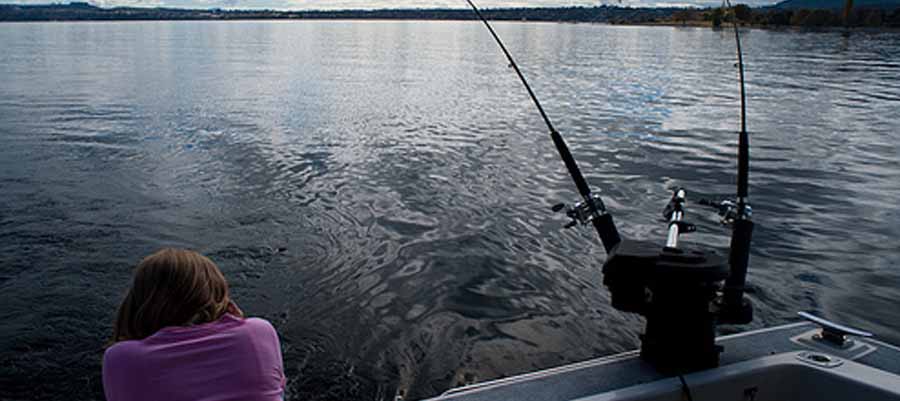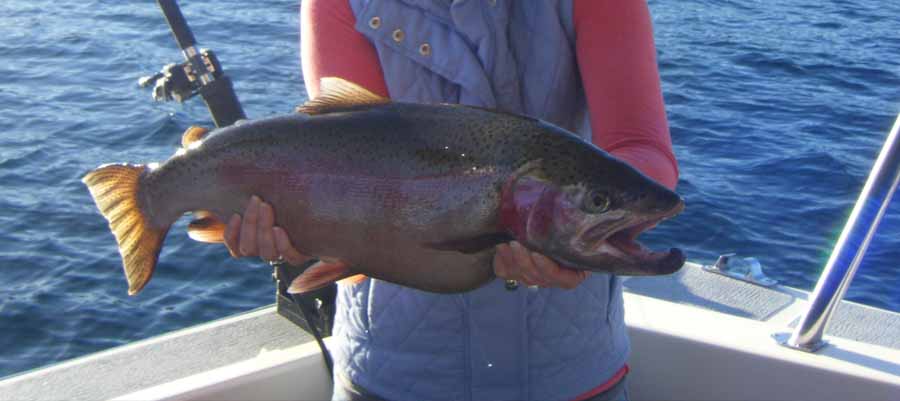Harling

Harling is probably the most exciting method for catching trout from a moving boat. You are targeting fish with light gear in shallow water (10ft to 25ft) where there is plenty of oxygen and they are actively feeding on smelt and bullies. The action can be fast and furious as the trout hit hard and, when hooked, tend to leap out of the water and make strong early runs.It is a method for the dedicated angler prepared to be out on the water at first light in the morning or dusk in the evening as the trout’s comfort zone is in the cooler water deep in the lake where they feel less exposed and vulnerable. The trout are drawn into the shallows by the prospect of an easy feed of smelt and bullies but prefer to be there under the cover of darkness and when the water temperature is lower. Once the sun hits the water they go back to the safety of the deep water and the catch rate falls off significantly until the sun goes down in the evening
The ideal tackle for harling is a light rod with a soft action capable of absorbing the shock of the hook up and strong early runs. One colour of lead on 300ft of backing will allow you to cover the shallows out to the drop off. A 20ft to 30ft leader (10lb or less) with one or two smelt or bully pattern flies complete the rig.
Deep Trolling – Downriggers

During the warmer months the surface waters of the lake reach 19 to 20 degrees and, during the day, the trout move into the cooler water deep in the lake. There they are out of reach to traditional trolling methods. Downriggers allow you to target trout at very precise depths down to 130ft or more and the bonus is you can use light monofilament or braid lines and catch fish throughout the day.A cable with a ten pound weight attached is lowered down to the required depth. The light lines are attached to the cable by pressure release clips. When a trout is hooked the line is released from the clip, the cable and weight can by raised and the angler gets to play the trout on a light sporting rig. It is not surprising that downriggers are the most popular way to troll for trout, particularly during the warmer months.
Jigging

Jigging has some real advantages and attractions over other boat fishing methods. It is one of the simplest ways of fishing from a boat and, given the right conditions and location, can be extremely productive. Jigging also allows you to target concentrations of fish at depths out of reach of other fishing methods. As you are fishing from an anchored or slowly drifting boat there is no engine noise to disturb the peace and the angler is holding the rod through-out the process so is directly involved from the hook-up to the net. Some local knowledge is required to find a suitable location and a concentration of fish and you may need to move around and experiment a bit to find the hot spot but, once you have, non-stop action and multiple hook-ups are common.
The rig required for jigging is a 6ft medium action rod with a bait casting style reel. As the trout often take the fly very gently the reel needs to be spooled up with non-stretch braided nylon and the angler must be vigilant and strike quickly to set the hook. With monofilament line in deep water the angler often won’t feel the trout take the fly and the strike will be too slow and too weak to set the hook.
The typical terminal tackle is 1.5 meters of 10lb monofilament with a 1.5oz sinker and two small flies on droppers .5m and 1m above the sinker. The line is free spooled out until the sinker hits the bottom. As the boat drifts line will need to be let out or retrieved to keep the line tight and the sinker on the bottom.
